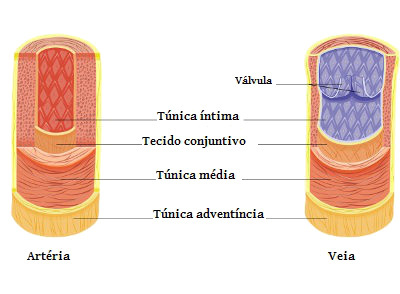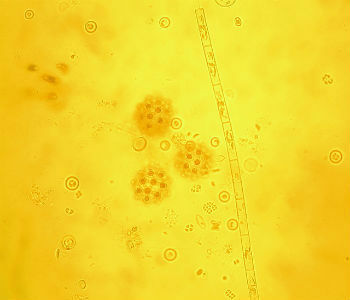You blood vessels, like the heart, they are components of the Cardiovascular system, also called the circulatory system. Although they are all blood-carrying vessels, there are some basic differences between vein, artery and capillary.
→ Feature common to blood vessels
You blood vessels they are usually formed by a few layers (tunics) in common: the tunica intima, tunica media and tunica adventitia. THE intimate tunic, innermost layer, is formed by endothelial cells that support connective tissue. Then we have the middle tunic, formed by smooth muscle cells and elastic tissue. Externally, we have the adventitious tunic, formed mainly by dense unshaped connective tissue and loose connective tissue.
Mind Map: Blood Vessels

*To download the mind map in PDF, Click here!
→ arteries
The arteries exit the heart and become thinner as they branch out. These vessels have as their main function carry blood and, consequently, nutrients and oxygen from the heart to the tissues.
Arteries carry blood under high pressure, so they need strong, elastic walls. As stated previously, blood vessels, in general, have three tunics, however, in the larger arteries, the tunica media is much thicker and rich in elastic fibers when compared to others vases.

Note the thickness of the tunica media of the artery and vein
Do not stop now... There's more after the advertising ;)
→ veins
At veins they result from the convergence of capillaries and become larger as they come closer to the heart. Unlike the arteries, the tunica media of the veins has fewer muscles and elastic fibers, and the blood pressure in these vessels is low.
The main task of the veins is bring blood from the body to the heart so it can be pumped back into the body. As some veins carry blood against gravity and blood pressure is low, these structures have some valves. These valves, formed by tunica intima folds, ensure the correct flow of blood towards the heart.
→ capillaries
Capillaries are very thin blood vessels, lacking the tunica media and adventitia, which form a complex network of vessels. Because they have a thin wall, with only a few layers of cells, they are an ideal place for gas exchange.
Curiosity:There is For some time, the term venous and arterial blood was used to indicate the blood that flowed in the veins and arteries, respectively. However, venous blood, which is rich in carbon dioxide, also circulates in arteries, more precisely in the pulmonary artery. The same happens with arterial blood, rich in oxygen, which circulates in the pulmonary veins. Therefore, it is inappropriate to say that in veins there is only venous blood and that in arteries there is only arterial blood.
By Ma. Vanessa dos Santos
Would you like to reference this text in a school or academic work? Look:
SANTOS, Vanessa Sardinha dos. "Difference between vein, artery and capillary"; Brazil School. Available in: https://brasilescola.uol.com.br/biologia/diferenca-entre-veia-arteria-capilar.htm. Accessed on June 27, 2021.


